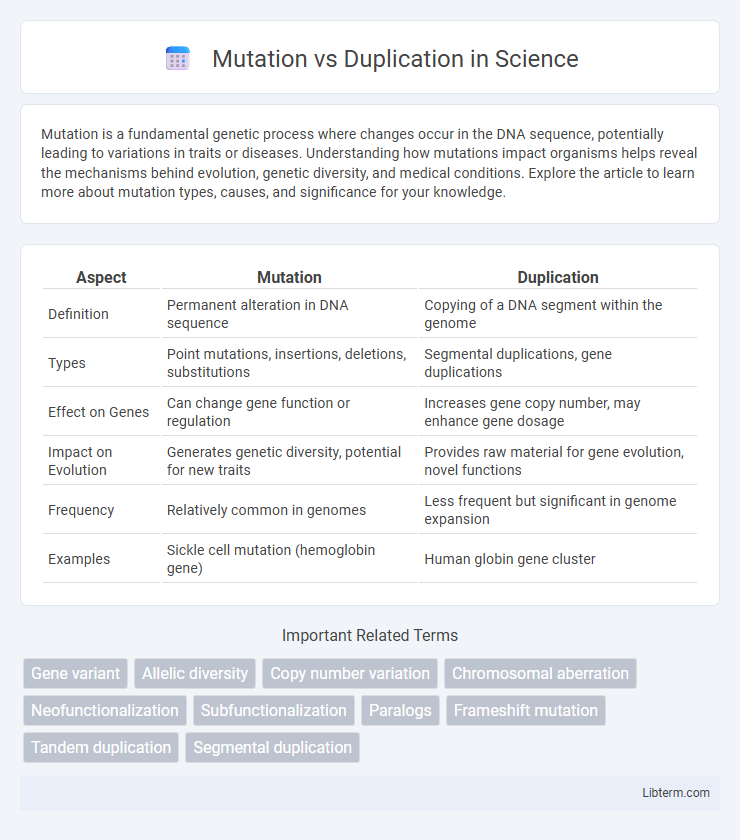Mutation is a fundamental genetic process where changes occur in the DNA sequence, potentially leading to variations in traits or diseases. Understanding how mutations impact organisms helps reveal the mechanisms behind evolution, genetic diversity, and medical conditions. Explore the article to learn more about mutation types, causes, and significance for your knowledge.
Table of Comparison
| Aspect | Mutation | Duplication |
|---|---|---|
| Definition | Permanent alteration in DNA sequence | Copying of a DNA segment within the genome |
| Types | Point mutations, insertions, deletions, substitutions | Segmental duplications, gene duplications |
| Effect on Genes | Can change gene function or regulation | Increases gene copy number, may enhance gene dosage |
| Impact on Evolution | Generates genetic diversity, potential for new traits | Provides raw material for gene evolution, novel functions |
| Frequency | Relatively common in genomes | Less frequent but significant in genome expansion |
| Examples | Sickle cell mutation (hemoglobin gene) | Human globin gene cluster |
Understanding Genetic Mutation
Genetic mutation involves permanent alterations in the DNA sequence that can affect an organism's traits, whereas duplication refers specifically to the copying of a DNA segment, leading to genetic redundancy. Understanding genetic mutations requires analyzing point mutations, insertions, deletions, and their impacts on protein function and phenotypic variation. These mutations serve as the primary source of genetic diversity and drive evolutionary processes by introducing novel genetic information.
Exploring Genetic Duplication
Genetic duplication involves the replication of a segment of DNA, resulting in multiple copies of that genomic region, which can drive evolutionary innovation by providing raw material for new gene functions. Unlike point mutations that alter nucleotide sequences, duplications expand genetic content and can lead to gene redundancy, neofunctionalization, or subfunctionalization. Research highlights that duplicated genes often undergo divergent evolution, contributing to phenotypic diversity and adaptation across species.
Key Differences Between Mutation and Duplication
Mutation refers to a change in the nucleotide sequence of DNA, often affecting a single gene or a small number of base pairs, leading to genetic variation or potentially harmful effects. Duplication involves the replication of a segment of DNA, resulting in multiple copies of a particular gene or chromosomal region, which can increase gene dosage and contribute to evolutionary innovation. Key differences include mutation altering gene sequences, often producing new alleles, while duplication increases genetic material without changing the existing sequence, impacting gene expression and genomic architecture.
Causes of Mutations in DNA
Mutations in DNA arise from various causes including replication errors, exposure to mutagenic chemicals, and radiation such as UV light or X-rays. Unlike duplication, which involves the copying of a DNA segment within the genome, mutations can result from base substitutions, insertions, deletions, or frame shifts affecting genetic sequences. Environmental factors and spontaneous molecular changes within DNA bases significantly contribute to the frequency and type of mutations observed.
Mechanisms Behind Gene Duplication
Gene duplication occurs primarily through mechanisms such as unequal crossing-over during meiosis, replication slippage, and retrotransposition, leading to the creation of extra copies of a gene within the genome. Unlike point mutations that alter a single nucleotide, duplication results in a larger-scale genomic change capable of increasing gene dosage and providing raw material for evolutionary innovation. These duplicated genes can diverge over time, potentially developing new functions or regulatory patterns, thereby contributing to genetic diversity and complexity.
Biological Consequences of Mutation
Mutations result in changes to the DNA sequence that can alter gene function, potentially leading to genetic disorders, cancers, or beneficial traits driving evolution. Unlike duplication, which increases gene copy number and can introduce redundancy or novel functions, mutations may disrupt protein coding, regulatory regions, or splice sites, impacting cellular processes. The biological consequences of mutations range from silent effects with no phenotype to severe impacts such as loss of function or gain of toxic function in critical genes.
Evolutionary Impact of Gene Duplication
Gene duplication plays a crucial role in evolutionary processes by providing raw genetic material for adaptation and innovation, allowing one gene copy to maintain its original function while the other diverges to acquire new functions. This mechanism increases genomic complexity and can lead to the development of novel traits and increased organismal fitness. Unlike point mutations, which typically alter existing gene functions, gene duplications expand gene families and drive long-term evolutionary change through functional specialization.
Detection Methods for Mutation and Duplication
Mutation detection methods include techniques such as Polymerase Chain Reaction (PCR), Sanger sequencing, and Next-Generation Sequencing (NGS), which allow precise identification of single nucleotide changes and small insertions/deletions. Duplication detection typically involves Comparative Genomic Hybridization (CGH), Microarray analysis, and quantitative PCR, which enable the detection of larger genomic segments with increased copy number. High-resolution sequencing combined with bioinformatics tools enhances the accuracy and resolution of both mutation and duplication analyses in genetic research and clinical diagnostics.
Mutation and Duplication in Human Diseases
Mutation involves changes in the DNA sequence that can disrupt gene function, leading to various human diseases such as cystic fibrosis, sickle cell anemia, and certain cancers. Duplication, a type of chromosomal abnormality where segments of DNA are copied, contributes to disorders like Charcot-Marie-Tooth disease and some forms of autism spectrum disorder by altering gene dosage and expression. Both mutation and duplication play critical roles in genetic variability and disease pathogenesis through distinct mechanisms affecting genome integrity and protein function.
Future Research Directions in Genetic Variation
Future research on mutation versus duplication in genetic variation aims to elucidate the distinct mechanisms and evolutionary impacts of these processes by integrating high-throughput sequencing and CRISPR-based gene editing technologies. Emphasis on investigating the role of duplication in adaptive evolution and complex trait diversity will improve understanding of genome plasticity and phenotype innovation. Advancements in computational models and multi-omics approaches will facilitate precise identification of functional consequences and clinical relevance of mutations and duplications in human disease and biodiversity.
Mutation Infographic

 libterm.com
libterm.com